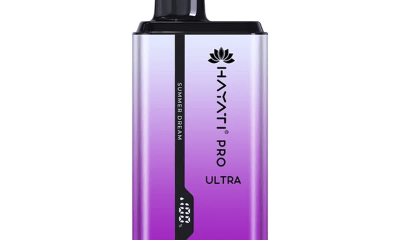Life Style
How to Save Water in the Shower?
Water is the utmost necessity of life, and it takes a lot of water to produce our food, generate the energy we use, and all the other essential things in life highly depend on water. We can’t imagine a day without water on earth. Conserving the water is crucial for the better future of our generations. Thus people find and invent ways to save it, and luckily the bathroom is one of the easiest places to save a considerable amount of water. As showering is an essential part of our everyday life, we can make little changes in our routine that will make a big difference in water consumption.
If you are also looking for tips on how to save water in the bathroom, this blog is a must-read for you.
Install a Water-Saving Showerhead

The quality and efficiency of any showerhead are measured by the number of gallons of water they deliver per minute. Standard showers provide 5 – 8 gallons per minute, whereas the water-saving showerheads provide 1.25 – 1.5 gallons per minute. It makes the showerhead water-efficient and eco-friendly. Moreover, these showers have several flow options or shower modes such as jetting, massage or rainfall. These showers are also known as spa showers for these exciting and relaxing modes. With an Eco water spa shower head, you can adjust the water mode according to your personal choice and enjoy spa experience at home.
You can easily find the best showerhead within your budget. And, if it costs you at first, water conservation will save you more money in the long run.
Install a Thermostatic Valve


People often turn on the shower before getting in and running for a couple of minutes to get the desired temperature. But during shower prep or morning madness, we waste a lot of water. The thermostatic valve is a life savior in this situation. It is a temperature-controlling device that attaches to your showerhead and your shower arm. When the water reaches 95 Degrees Fahrenheit, it automatically shuts off the water. And, once you are ready to take a shower, pull down the release cord and enjoy the nice, hot temperature water shower.
Learn Some Water Saving Tips
Here are some ways that will reduce your worries on how to save water in the shower;
- If you don’t have enough budget to install a thermostatic valve; use a bucket to fill up the water until it warms up and use it later for watering plants, cleaning or flushing the toilet.
- You can efficiently save water in the shower by reducing the flow when leathering up. Instead of shutting off the valve, you can pause it using a flow reducer or shut-off valve.
- Women often have a habit of shaving under a running tap and waste plenty of water. Place a bowl of water or gather it in the sink for cleaning the razor off while shaving. It is a much better approach than using running water. In this way, you can save much more water than you’d expect. Also turn off the tap while brushing teeth or scrubbing skin.


- Take a bath as an occasional treat and use showers more. The standard bath uses 30 to 40 water gallons while a 10-minute shower with a water saving showerhead only uses 20 – 25 gallons.
- The duration of the shower has a direct effect on water usage. A standard shower consumes more than 12 liters of water per minute. If you reduce your shower duration from 5 to 10 minutes, you can minimize your water consumption by up to 22 thousand liters every year. And a small family would save up to 87 thousand liters of water in one year. That’s much more!
Life Style
Shutterbug’s Paradise: Japan Photography Expedition Destinations


Greetings and welcome to the photographer’s paradise, where each frame captures a moment of beauty and each corner narrates a unique story. Japan, with its abundant natural beauty, historical significance, and cultural diversity, is an idyllic haven for photographers aspiring to capture the essence of the world. Japan, spanning from the vibrant thoroughfares of Tokyo to the tranquil scenery of Hokkaido, presents an innumerable array of photographic expedition locales ripe for exploration. There is an alluring sight for every photographer, be it the serene reflection of autumn foliage on a Kyoto pond or the vivid hues of springtime cherry blossoms. Furthermore, the utilization of eSIM for Japan has significantly simplified the process of traversing the varied landscape of Japan, enabling one to maintain connectivity in Japan and disseminate photographic experiences on a global scale. We cordially invite you to accompany us on an online exploration of the foremost photography expedition sites in Japan. With every action taken, we advance in our endeavor to faithfully capture the allure of this enchanting nation.
- Japan’s Appeal to Photographers
Japan entices photographers with its captivating fusion of modernity and tradition, providing an extensive array of subjects to be documented through the lens. Urban photography is boundlessly enhanced by the presence of vivacious street scenes and iconic landmarks in the center of bustling metropolises such as Tokyo. In the interim, the picturesque traditional tea houses and ancient temples of Kyoto provide a glimpse into the abundant cultural heritage of Japan, thereby motivating photographers to encapsulate the ambiance of the past. Japan’s natural aesthetics are evident in its picturesque coastlines, majestic mountains, and verdant forests, which extend beyond the urban landscape. Seasonally, photographs are presented with a distinct assortment of colors and textures, ranging from the vibrant tints of autumn leaves to the delicate petals of spring. Japan’s wide array of photogenic environments attracts a multitude of international photographers who are eager to discover its concealed marvels and impart their distinctive viewpoints to a global audience.
- Tokyo: The Pleasure of Urban Photography
Tokyo, the dynamic metropolis of Japan, serves as an ideal location for urban photographers to capture the lively dynamism of the city. Tokyo presents a wide range of photographic prospects in every direction, from the tranquil gardens of Meiji Shrine to the vibrant streets of Shibuya. Architectural photography can be inspired by the captivating ambiance of Tsukiji and Ameya-Yokocho markets, which offer insights into the city’s daily existence, in addition to the architectural splendor provided by renowned landmarks like the Tokyo Tower and Senso-ji Temple. The bustling alleyways of Shinjuku, as well as the stylish districts of Harajuku and Ginza, offer street photographers boundless prospects to encapsulate the unique ambiance of Tokyo’s eclectic culture. Tokyo, renowned for its exciting fusion of modernity and tradition, consistently serves as a source of inspiration for photographers seeking to explore the limits of their imagination and encapsulate the essence of Japanese urban existence.
- Kyoto: Gems of Cultural Photography
Japan’s ancient capital, Kyoto, offers photographers an abundance of cultural riches ripe for exploring. Kyoto, which is replete with more than 2,000 sanctuaries and temples, provides an abundance of opportunities to photograph the splendor of traditional Japanese landscapes and architecture. Historic landmarks in Kyoto, such as the renowned torii gates of Fushimi Inari Shrine and the golden pavilion of Kinkaku-ji, offer awe-inspiring settings for photographers desiring to immerse themselves in the profound cultural legacy of Japan. Kyoto’s serene gardens and picturesque bamboo woodlands, situated beyond the temples, present an idyllic ambiance and unspoiled splendor that are ideal for reflective landscape photography. Kyoto, renowned for its enduring allure and timeless beauty, is an ideal destination for photographers aiming to encapsulate the fundamental aspects of Japan’s spiritual heritage and cultural identity.
- Hokkaido: A Photographic Playground in Nature
Hokkaido, the northernmost territory in Japan, features some of the most magnificent natural landscapes in the nation, making it a photographer’s paradise. Hokkaido presents boundless possibilities for depicting the splendor of the natural environment, ranging from the rugged summits of the Daisetsuzan Mountains to the immaculate margins of Lake Shikotsu. Fields of wildflowers blossom in the spring, adorning the landscape with vivid hues that captivate the attention of photographers. As the foliage transforms from green to crimson, orange, and gold in the autumn, the forests become a mesmerizing setting for landscape photography. And during the winter, Hokkaido becomes a winter paradise, providing photographers with breathtaking subjects in the form of snow-covered landscapes and frozen cascades that capture the enchantment of the season. Hokkaido, a region situated in northern Japan, offers an ideal setting for nature photographers aiming to capture the unspoiled splendor of its pristine wilderness and breathtaking landscapes.
- Tropical Paradise Photography in Okinawa
The southernmost prefecture of Japan, Okinawa, is a tropical sanctuary that offers photographers an opportunity to discover a different aspect of Japan. Okinawa, with its verdant forests, white sand beaches, and azure waters, offers inexhaustible possibilities for depicting the splendor of the tropics. Landscape photographers can capture the rugged cliffs and dramatic seascapes that line the coast of Okinawa, while underwater photographers will be enthralled by the vibrant coral reefs and abundant marine life that flourish in the balmy waters of the island. Photographers aiming to encapsulate the essence of island life are further inspired by Okinawa’s distinctive history and culture, which extend beyond the island’s beaches. The vibrant cultural festivals and traditional Ryukyu architecture of Okinawa provide photographers with an abundance of subject matter to investigate and capture with their optics. Okinawa, a tropical sanctuary renowned for its serene ambiance and breathtaking natural landscapes, presents a singular and motivational setting for photographers aiming to encapsulate the fundamental qualities of the southernmost islands of Japan.
Conclusion
As our exploration of the photography expedition destinations in Japan draws to a close, we are once again struck by the abundance of captivating sights and experiences that this nation has to offer. Japan’s abundant cultural diversity and varied topography—from the vibrant streets of Tokyo to the tranquil landscapes of Hokkaido and the tropical utopia of Okinawa—offer photographers of all skill levels an inexhaustible supply of inspiration. There is something for every shutterbug to adore, whether it be the natural majesty of Hokkaido’s wilderness or the ancient temples and historic monuments of Kyoto. Furthermore, the utilization of eSIM by travelers has significantly simplified the process of traversing the varied landscapes of Japan, enabling photographers to maintain correspondence and disseminate their experiences globally. Consider undertaking a photography expedition to Japan, whether you are an experienced professional or an amateur aficionado, with the intention of documenting the captivating beauty and essence of this nation through your lens. Uncertainty surrounds the depths of what concealed treasures you may discover and the narratives your photographs may depict. It is a worthwhile journey that will provide you with cherished memories and inspiring images to ponder in the years to come.
Life Style
Harmony in the Kitchen: The Dynamic Duo of Laurel Budapest Shaping the Future of Fine Dining


Fine dining, a culinary art form that exceeds simple eating into an immersive experience of taste, presentation, and atmosphere, has become a significant part of the global dining scene. This dining approach emphasizes the careful preparation and presentation of food, aiming to provide customers not just a meal, but a memorable experience. At the heart of this experience is often a leading chef, whose vision and creativity set the tone for the entire establishment. However, a rising trend in the culinary world is the concept of chef duos leading a restaurant, bringing together their collective skills, creativity, and perspectives to elevate the dining experience to new heights. This article explores the dynamics of solo versus duo chef leadership in fine dining establishments, with a focus on Laurel Budapest, a restaurant in Budapest that exemplifies the benefits of a chef partnership.
In the realm of fine dining, the leadership style in the kitchen can significantly influence the restaurant’s identity, menu, and overall dining experience. Traditionally, a single chef has led fine dining kitchens, embodying the restaurant’s culinary philosophy and ensuring consistency and excellence. This model allows for a clear, singular vision, with the head chef’s personal touch evident in every aspect of the dining experience. The benefits of this approach include a strong personal brand and a cohesive culinary narrative that can attract patrons interested in the chef’s specific style and philosophy.
However, the collaboration between two chefs can introduce a dynamic interaction of ideas, techniques, and flavors, leading to innovative and diverse culinary creations. A chef duo can merge distinct culinary backgrounds and expertise, nurturing an environment of creativity and experimentation. This partnership can also offer practical advantages, such as sharing the workload, enabling a more balanced lifestyle for the chefs, and providing continuity and stability for the establishment. The synergy of a chef duo can enhance the dining experience by offering a broader range of flavors, textures, and culinary concepts, appealing to a wider audience and keeping the menu fresh and exciting.
An exemplary case of successful chef partnership is found in Budapest, at the Laurel Budapest restaurant. Following the departure of Ádám Mede, Laurel Budapest introduced a unique and surprising concept by appointing a chef duo to lead its kitchen: pastry chef Ötvös Zsuzsanna and head chef Szabó Dávid. This decision marked a significant shift in the restaurant’s direction, emphasizing collaboration, innovation, and sustainability. The duo’s combined expertise has brought a fresh perspective to the restaurant, integrating their diverse skills into a cohesive and innovative menu that includes vegan dishes and challenges the traditional boundaries of fine dining.
Laurel Restaurant Budapest stands out as a must-visit destination for those seeking an exceptional fine dining Budapest experience. The restaurant, recommended by Michelin and nestled in the heart of Budapest, offers a gateway to Budapest luxury dining through its innovative tasting menu. The chefs’ shared vision and collaborative spirit are evident in their approach to menu creation, focusing on sustainability, creativity, and the integration of unique, high-quality ingredients. Their combined efforts have led to the crafting of exquisite dishes that reflect both their individual talents and their shared culinary philosophy.
The advantages of a chef duo at the helm of a fine dining establishment are varied. It allows for a more diverse and innovative menu, reflecting a blend of culinary styles and preferences. This partnership fosters a creative environment where ideas can be shared and challenged, leading to unique culinary creations. Additionally, it offers practical benefits in terms of workload distribution, potentially leading to a better work-life balance and a more sustainable work environment.
For visitors and locals alike, fine dining in Budapest offers a unique opportunity to explore the city’s rich culinary landscape. Laurel Budapest, in particular, stands as a example of Budapest luxury dining, inviting guests to embark on a gastronomic journey that transcends the ordinary. With its chef duo at the helm, the restaurant demonstrates the innovative spirit of contemporary cuisine, blending traditional Hungarian flavors with global culinary trends. The result is a tasting menu Budapest that not only showcases the chefs’ technical prowess and creative vision but also tells a story of Budapest’s culinary heritage and its place in the global dining scene.
The interview of the Dining Guide with Ötvös Zsuzsanna and Szabó Dávid sheds light on their collaborative process, highlighting the advantages of working as a chef duo. Their partnership allows for a more dynamic and flexible approach to menu development, with each chef bringing their unique perspective and expertise to the table. This collaboration results in a more diverse and innovative menu, offering guests a multifaceted dining experience that challenges and delights the palate. Moreover, their focus on sustainability and the use of high-quality, locally sourced ingredients speaks to a broader trend in the culinary world, where environmental consciousness and ethical sourcing are becoming increasingly important.
The success of Laurel Budapest under the leadership of Ötvös Zsuzsanna and Szabó Dávid illustrates the potential of chef partnerships in the fine dining industry. By combining their strengths, the chef duo has created a dining experience that is both innovative and deeply rooted in the local culinary tradition. This approach not only enhances the dining experience for guests but also sets a new standard for culinary excellence and creativity in Budapest.
In conclusion, the rise of chef duos in fine dining represents a shift towards a more collaborative and innovative approach to cuisine. Laurel Budapest serves as a prime example of how two chefs can come together to create a unique and memorable dining experience that highlights the best of both their individual talents and their shared vision. For those seeking an exceptional fine dining experience in Budapest, Laurel Budapest is a destination that promises not only exquisite cuisine but also a glimpse into the future of culinary excellence. With its innovative tasting menu and commitment to sustainability, Laurel Budapest stands as a testament to the creative potential of chef partnerships in the world of fine dining.
Laurel Budapest
web: www.laurelbudapest.hu/en
Phone: +36 20 369 5922
e-mail: [email protected]
facebook: https://www.facebook.com/laurelbudapest
Instagram: https://www.instagram.com/laurelbudapest
Life Style
Discovering the Tastes of Charleston SC: A Kid’s Guide to Food Tours


Imagine stepping into a city where every street and corner tells a story, especially through its food. Welcome to Charleston, SC, a place bursting with flavors and history. Here, we’ll embark on a journey, not just any journey, but a delicious adventure exploring Charleston’s food. As we dive into this guide, think of it as your treasure map, leading to hidden gems where every bite is a discovery of taste and tradition. So, grab your curiosity and appetite, and let’s set off to uncover the mouth-watering secrets of Charleston together. This is your invitation to a tasty exploration like no other!
Why Explore Charleston Through Food?
Exploring Charleston through its food is like going on a treasure hunt where each dish is a clue to the city’s story. Just as adventurers love discovering new lands, you’ll love tasting different foods that show you what makes Charleston special. Every snack, sweet, or meal shares a piece of Charleston’s history and invites you to be part of its ongoing story. So, by eating your way around the city, you’re not just enjoying delicious bites; you’re learning and connecting with Charleston in a unique way.
Types of Food Tours in Charleston
Food tours in Charleston SC offers that are like different paths in a magical forest. Some tours take you through the world of traditional dishes, where you can taste the city’s history in every bite. Others might focus on sweets, turning your journey into a sugary dream. There are also tours that explore modern twists on classic foods, showing how chefs in Charleston are like wizards, creating new spells with flavors. Each tour is a different adventure, waiting for you to discover.
What to Expect on a Food Tour
On a food tour in Charleston, you’ll hop from one amazing place to another, trying bits of everything. It’s like going to a food festival where every stand has a new dish to try. You’ll learn fun facts about what you’re eating and the stories behind them, making each bite more interesting. Even if you’re picky, there’s sure to be something you’ll love. The best part? You get to do all this with other food adventurers, making new friends along the way.
Fun Foods to Try
Charleston’s food scene is a playground for your taste buds. Imagine diving into a dish of shrimp and grits, feeling the warm, creamy grits mixed with the juicy shrimp. Or biting into a piece of barbecue that’s so tender and flavorful, it feels like a hug for your mouth. And for dessert, there’s nothing like the crispy, sweet benne wafers, a Charleston classic. These are just a few of the must-try treats waiting for you.
Tips for Enjoying Your Food Tour
To make the most of your Charleston food tour adventure, remember a few handy tips. Wear comfortable shoes because you’ll be walking to different spots. Bring a water bottle to stay hydrated between tastings. And don’t forget to bring your sense of adventure and an empty stomach, so you can try as many dishes as possible. Most importantly, be ready to have fun and enjoy every moment of your delicious journey.
Final Thought
Embarking on a food tour in Charleston is not just about eating; it’s about discovering, learning, and making memories. With every bite, you connect deeper with the city’s culture and history. So, gather your family or friends, book a tour, and get ready to explore the flavors of Charleston. Who knows? You might just find your new favorite dish or make a new friend. The adventure awaits!
-



 Biography5 years ago
Biography5 years agoJacqulyn Elizabeth Hanley is the Mother of Liza Soberano?
-



 Home4 years ago
Home4 years agoEpson L3110 Driver Free Download Latest Updated Version
-



 Games3 years ago
Games3 years agoBest Free To Play MMORPG To Try This 2021
-



 Biography5 years ago
Biography5 years agoAmanda Levy Mckeehan Biography, Family, Net Worth, Age, Affairs, Facts
-



 Biography5 years ago
Biography5 years agoWho is Rose Dorothy Dauriac? Scarlett Johansson Daughter?
-



 Biography5 years ago
Biography5 years agoJessica Ditzel Secret Information that Nobody Knows | Joe Rogan’s Wife
-



 Biography5 years ago
Biography5 years agoWhat is the relation of Nathaniel Larry Osorno with Liza Soberano?
-



 Home5 years ago
Home5 years agoLiza Soberano Biography, Age, Family and Boyfriends































